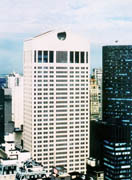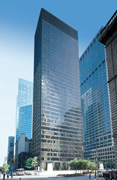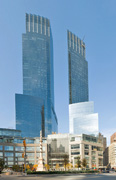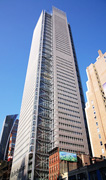Germany in the 1940s was not the safest place to be. Among the many citizens to realize that were a group of eminent architects who sought refuge in American universities and schools. This changed the look of America forever -- their students absorbed the new and shocking ideas these Europeans had come up with. After their graduation, buildings started to look different. Sleeker, simpler in form, taller in size. It was the coming of the modern architecture. And New York happens to be a potent showcase of its best results.

Sony's headquarters in New York epitomize the postmodern style that towards the end of the 20th century defied the conventions of the time in architecture and offered constructions that were more aesthetic than functional.
You can see for yourself even before you get to the building -- we recommend recommend approaching it from 57th street (the building is at 56th), so you can look up from the right angle and see its famous top and how it differs from the adjacent IBM building. The top -- a sloping inverted V with a notch in the center -- is the building's most defining characteristic, earning the building its nickname ("Chippendale", as per the 18th-century British cabinet maker who would always top his products like that) and making it stand out in the Madison Avenue skyline. However, you should not neglect the entrance, a monumentally tall (seven stories, no less) arched space where the extensively paneled windows make for some very handsome light effects.
When you are in, and since you've passed security, pay a visit to The Spirit of Communications -- a statue very much beloved by New Yorkers, which now resides in the Sony entranceway after a series of moves to different places.

It doesn't take a degree in architecture to get a kick out this beautiful, original building at 375 Park Avenue. Designed by the ultimate American modernist, Mies van der Roe, it is one of the most distinct erections in New York -- Van der Roe rethought the concept of a skyscraper from scratch and argued that it should be decorated by its very structural elements only, instead of hiding them and adding ornaments later.
As result, the construction has an honesty to it which surprised New Yorkers -- here was a highly aesthetic yet functional skyscraper in its steel and reinforced concrete nakedness. But there's a twist that makes the Seagram even more fascinating: the windows are designed so you can't see what's going on inside and yet you can get see what is happening outside. Which conveys a closed mentality in stark contrast with the building's structural honesty. So it's not only a beautiful skyscraper to behold, and not only the prime example of modernist architecture in New York -- it's also a building with a complex personality.

In 1985, a rare 4.5-acre space opened up in one of Manhattan's neuralgic centers, the Columbus Circle -- the city had decided to to demolish a convention center built in the 50's called the New York Coliseum to build something else. Being one of the most coveted spots in the world, it took about 15 years to decide exactly what. (The process, however, resurrected the very New York habit of attempting to build the tallest building in the world, which had frankly been lost for a few years.)
After much protestation because some projects would cast a shadow over Central Park, it was decided to make two 750-feet-tall towers in late modern style and call the Time-Warner Center since it was a result of media companies merger. The Coliseum was finally demolished in 2000.
It turned out to be a healthy wait. Construction was already underway by September 11, 2001 when the Twin Towers were attacked. A year and a half later, the Time-Warner Center was inaugurated. Some just commented that it looked similar to the fallen Twin Towers. Others were just relieved to see the city regaining its pulse.

Long paragraphs could be written about the New York Times influence on New York, how The flag may be an undisputed symbol of top-quality written journalism worldwide but it will always belong to the Big Apple. But it suffices to say Times Square got its name when the newspaper moved its headquarters there in 1904.
So when it announced that it would get its own skyscraper, it only seemed a natural. What's more, it made the 1,046-feet-tall construction a building a must-see spot both for its historically inherent relationship with New York City and for the sheer thrill of visiting the Mecca of quality reporting.